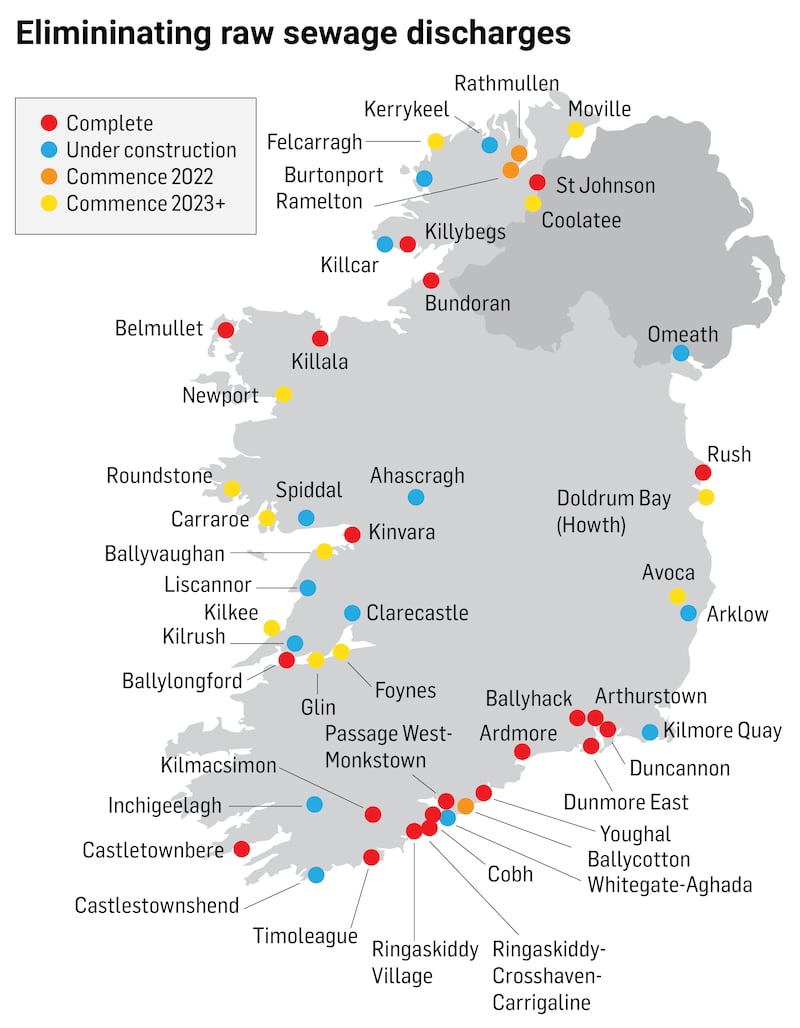Only half of Ireland’s sewage was treated to EU environmental standards in 2021 — well below the EU average of 90 per cent, according to the latest Environmental Protection Agency (EPA) report on urban wastewater treatment.
The report for 2021, released on Thursday, says Ireland has failed to comply with the required standards since 2005.
It will take 20 years of sustained “multibillion-euro investment” by Irish Water to get all plants up to the required standard, the agency concludes.
While investment in wastewater infrastructure by the utility is delivering improvements to priority areas identified by the agency, “treatment at many areas is still not as good as it needs to be”.
“Irish Water does not have clear plans in place to deal with a third of the priority areas where wastewater is adversely impacting the environment and has not allocated resources in its investment plan to complete improvements at these areas,” it adds.
Works to eliminate raw sewage flowing into seas and rivers from 32 towns and villages have begun or are due to start by 2024, the report confirms. The utility, however, “must provide for all improvements needed at these areas in its next investment plan, which covers the period 2025-2029″.
“This report shows that targeting investment at the priority areas identified by the EPA is delivering improvements in water quality, and the elimination of raw sewage discharges from Cobh and Castletownbere in Cork are good examples of progress,” said director Dr Tom Ryan.
Irish Water had, however, failed to produce action plans to improve treatment at a third of the priority areas identified by the agency where wastewater is harming our rivers, lakes and coastal waters, he said. “Clear, site-specific action plans and time frames to improve treatment in these areas.”
“Ireland’s largest treatment plant at Ringsend in Dublin is overloaded and fails to consistently treat sewage to the required standards,” the report finds. A major upgrade of the plant costing €500 million began in 2018 and is due to be completed in 2025.
Almost half of Ireland’s urban wastewater is generated in the 12 areas that failed EU standards, with most of this produced in the greater Dublin area and conveyed to the Ringsend plant.
While construction work to provide treatment for the 32 areas discharging raw sewage listed in the report is either ongoing or due to start in the next two years, “it is essential that Irish Water delivers these projects as soon as possible”, it says.
“Sixteen years after the final deadline to comply, half of Ireland’s sewage is still not treated to the standards set to protect the environment,” the agency’s programme manager Noel Byrne said.
“It is particularly concerning to see some towns such as Ballymote in Sligo failing in 2021, despite having the necessary treatment infrastructure and meeting the standards in 2020. This highlights the need for improved vigilance and oversight by Irish Water to make sure treatment infrastructure is always operated at its optimum,” he said.
Irish Water needs to improve its information on the condition and performance of sewers to inform and plan upgrade works necessary to mitigate environmental risks from sewer overflows, the report finds.
Available resources must be directed where they are most needed and will bring the greatest benefits in line with its priority list, it says. These include 32 towns and villages “still discharging raw sewage into our environment every day in mid-2022″, and large towns and cities not treating sewage to EU standards — Malahide, Dublin (Ringsend), Arklow, Mitchelstown, Rathcormac, Cobh, Lahinch, Moville, Ballymote, Kinsale, Clonakilty and the combined area of Ringaskiddy, Crosshaven and Carrigaline.

Irish Water response
Irish Water defended its performance, citing a record level of €367 million invested in wastewater infrastructure last year. Since it assumed responsibility for public water services in 2014, 60 per cent of raw sewage discharges by volume have been eliminated through targeted investment in new sewerage infrastructure where none existed previously, “and we are on target to eliminate nearly all of the remainder by 2025″, it said.
This had been achieved by building new wastewater plants and networks in 21 towns where treatment had never existed before. This new infrastructure had stopped discharge of about 20 million litres of raw sewage every day, equivalent to the sewage generated by more than 100,000 people.
It has achieved 93 per cent compliance with the EU Urban Wastewater Treatment Directive at its treatment plants, it confirmed.
“In 2021/2022 we have made significant progress, with 14 new locations where contracts were signed and/or projects started on site, leaving just 15 areas (representing less than 10 per cent of the total volume of raw sewage discharge) to start from 2023 onwards,” it said.
In some of these areas it overcame complex planning and approval issues, such as in Arklow where construction of a new wastewater treatment plant got underway in 2021 to end the discharge of raw sewage into the River Avoca.
“Irish Water is committed to protecting and enhancing our natural environment by ensuring the highest standards are applied to wastewater treatment throughout Ireland,” said infrastructure delivery director Brian Sheehan.
“We have prioritised key programmes such as the elimination of raw sewage and upgrading of existing infrastructure. This approach is focused on the catchments where wastewater is a significant pressure on water quality and where the investment of public money will make a meaningful difference to overall water quality,” he added.
“We have seen the impact of these improvements in areas such as Shannon, Co Clare and Cork City where we completed upgrades in 2021. Local residents and businesses are already seeing the benefits of this investment in cleaner waters, improved natural environment and increased opportunities for housing and economic development.”












